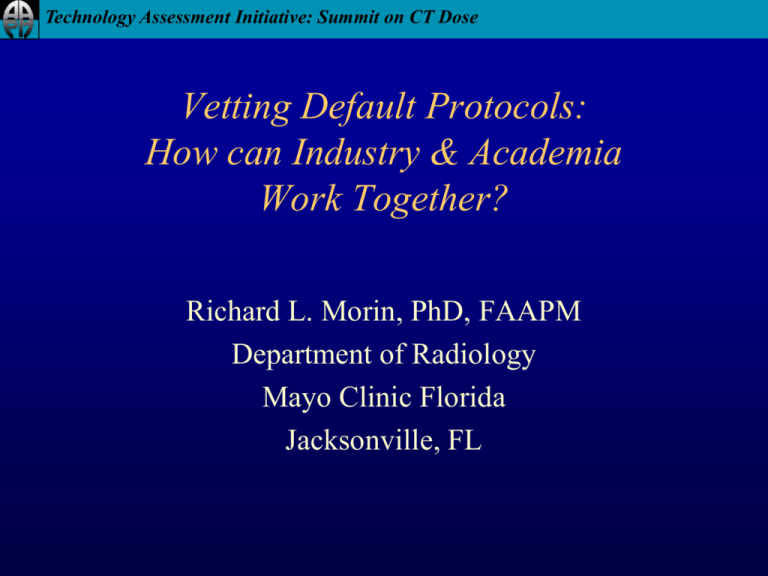Vetting Default Protocols: How can Industry & Academia Work
advertisement

Technology Assessment Initiative: Summit on CT Dose Vetting Default Protocols: How can Industry & Academia Work Together? Richard L. Morin, PhD, FAAPM Department of Radiology Mayo Clinic Florida Jacksonville, FL Technology Assessment Initiative: Summit on CT Dose Questions • How are vendor default scanner protocols determined? • Are they always optimal? • Are they ever wrong? • How can academia and professional societies have an impact on default protocols? Technology Assessment Initiative: Summit on CT Dose Example of “not-optimal” • Protocols sometimes tend to be European-centric – “First thing we do with their scanner is increase all the default dose levels and choose a sharper kernel” Technology Assessment Initiative: Summit on CT Dose Some general observations • U.S. – Highly litigious – Diagnostic accuracy is top priority – High obesity rates • reference mAs – Chest – 170-180 mAs – Abd – 200-240 mAs – B40 kernel • Europe/Asia – Litigation less common – Dose limitations are top priority – Lower obesity rates • reference mAs – Chest – 130 mAs – Abd – 160 mAs – B30 kernel Technology Assessment Initiative: Summit on CT Dose THE AMERICAN EXPERIENCE • A number of years ago, a colleague said to me – “I’ve gotten sued for missing findings on suboptimal images, but never for using too much mA” Courtesy of Robert Zeman, MD Technology Assessment Initiative: Summit on CT Dose Another example of “not-optimal” • Selecting the optimal detector configuration Technology Assessment Institute: Summit on CT Dose Prospective images at 5mm Scanner: 16-channel Detector: 8 x 2.5 Pitch = 0.875 Retrospective images at 2.5mm Technology Assessment Institute: Summit on CT Dose Bubble Phantom (side view) Scan plane Air bubble Cylinder Table motion Technology Assessment Institute: Summit on CT Dose Same as patient study Pitch: 0.875, Detector: 8×2.5mm, Beam: 20mm SE 2, IM 2, 5mm SE 3, IM 3, 2.5mm Technology Assessment Institute: Summit on CT Dose Change detector (incr. Z sampling), retain beam width Pitch: 1.375, Detector: 16×1.25mm, Beam: 20mm Effective mAs = 109 (decreased from 171) SE 10, IM 2, 5mm SE 11, IM 3, 2.5mm Technology Assessment Institute: Summit on CT Dose Change detector (incr. Z sampling), retain beam width Pitch: 1.375, Detector: 16×1.25mm, Beam: 20mm Effective mAs = 109 (decreased from 171) SE 10, IM 2, 5mm SE 11, IM 3, 2.5mm Technology Assessment Initiative: Summit on CT Dose Z-axis Sampling Summary • In general, use smallest detector spacing possible! • More powerful than decreasing pitch to reduce helical artifacts • Beam width may change with detector configuration • Changes in beam width and/or pitch will affect total scan acquisition time and may affect dose Technology Assessment Initiative: Summit on CT Dose Example of “wrong” • Initial multi-slice scanner (4-slice) – Shorter tube to isocenter distance than same vendor’s single-slice scanner – Required 20% less mAs at given kVp and slice width to achieve the same noise vs. single slice scanner Technology Assessment Initiative: Summit on CT Dose Routine Head Exam for ACR Accreditation • Scanner default protocol: – Used thinnest collimation setting • Factor of 2 dose penalty on early 4-slice systems compared to single slice 5-mm scan – Meant to use same mAs as single-slice protocol (170 mA, 2 sec) – Used factor of 2 higher mAs by mistake (340 mA, 2 sec) • Result: – Single-slice scanner default CTDIvol = 45 mGy – Multi-slice scanner default CTDIvol = 190 mGy – Several sites submitted to ACR using these settings/doses Technology Assessment Initiative: Summit on CT Dose Vendor Supplied Protocols • Methods – Physicists & Engineers – Partners – Follow-up Technology Assessment Initiative: Summit on CT Dose Vender Supplied Protocols (con’t) • Options – – – – STOP BAU Generic Groups National Consensus Technology Assessment Initiative: Summit on CT Dose Vendor Supplied Protocols (con’t) • Tradeoffs – – – – – Partners feedback Regulations Innovation Scientific Community Sales Technology Assessment Initiative: Summit on CT Dose Literature • • • • • Timelines Evidence Based Vender Proprieties Cottage Industry Culture Technology Assessment Initiative: Summit on CT Dose Future Things Will Get Better Technology Assessment Initiative: Summit on CT Dose Future • • • • • • • Protocol Review Committee Team Decisions Image Quality & Dose Discussions Public Workshops & Forums AAPM protocol web site Widespread transparent vetting of details Vendor & Imaging Community Solutions Technology Assessment Initiative: Summit on CT Dose Future





